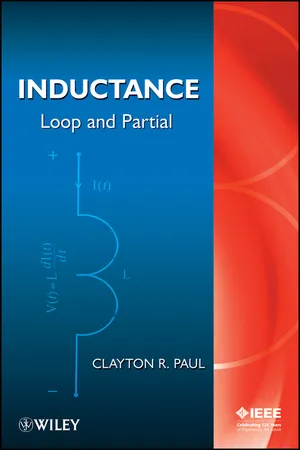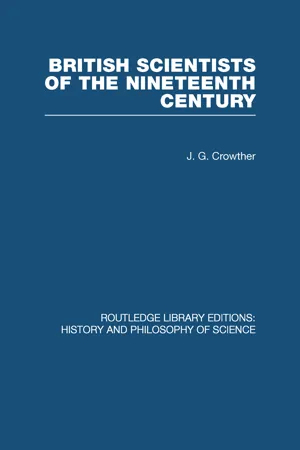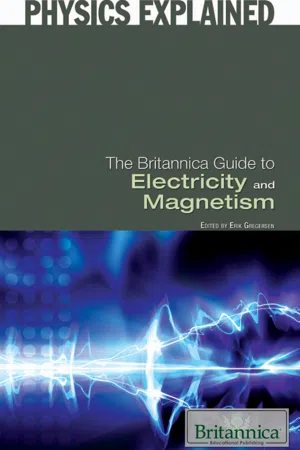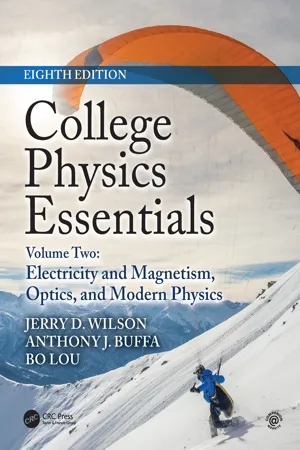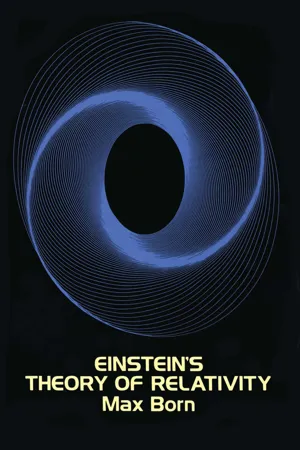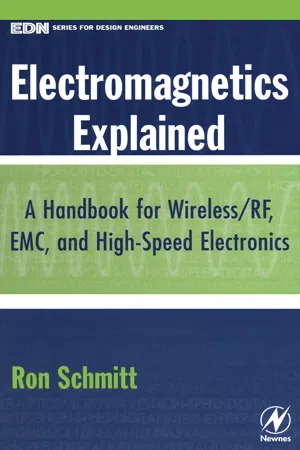Physics
Faraday's Law
Faraday's Law states that a changing magnetic field induces an electromotive force (EMF) in a conductor. This phenomenon is the basis for the operation of generators and transformers. The law quantifies the relationship between the rate of change of the magnetic field and the induced EMF, providing a fundamental principle for understanding electromagnetic induction.
Written by Perlego with AI-assistance
Related key terms
Related key terms
1 of 4
Related key terms
1 of 3
11 Key excerpts on "Faraday's Law"
- eBook - ePub
- Jo Verhaevert(Author)
- 2024(Publication Date)
- Routledge(Publisher)
Chapter 5 Electromagnetism
DOI: 10.1201/9781003308294-5Learning Outcomes This chapter concerns the principles and laws governing electromagnetic induction and the concepts of self and mutual inductance. On completion of this chapter you should be able to use these principles to:- Understand the basic operating principles of motors and generators.
- Carry out simple calculations involving the generation of voltage, and the production of force and torque.
- Appreciate the significance of eddy current loss.
- Determine the value of inductors, and apply the concepts of self and mutual inductance to the operating principles of transformers.
- Calculate the energy stored in a magnetic field.
- Explain the principle of the moving coil metre and carry out simple calculations for the instrument.
5.1 Faraday’s Law of Electromagnetic Induction
It is mainly due to the pioneering work of Michael Faraday, in the nineteenth century, that the modern technological world exists as we know it. Without the development of the generation of electrical power, such advances would have been impossible. Thus, although the concepts involved with electromagnetic induction are very simple, they have far-reaching influence. Faraday’s law is best considered in two interrelated parts:- The value of emf induced in a circuit or conductor is directly proportional to the rate of change of magnetic flux linking with it.
- The polarity of such an emf, induced by an increasing flux, is opposite to that induced by a decreasing flux.
The key to electromagnetic induction is contained in part 1 of the law quoted above. Here, the words ‘rate of change’ are used. If there is no change in flux, or the way in which this flux links with a conductor, then no emf will be induced. The proof of the law can be very simply demonstrated. Consider a coil of wire, a permanent bar magnet and a galvanometer as illustrated in Figures 5.1 and 5.2 - eBook - ePub
Inductance
Loop and Partial
- Clayton R. Paul(Author)
- 2011(Publication Date)
- Wiley-IEEE Press(Publisher)
In the remaining chapters we discuss the computation of the inductance of a closed loop that is constructed of a conductor such as a wire or a land on a printed circuit board. This final section will serve as a preliminary to those discussions.Faraday’s fundamental law of induction indicates that an electromotive force is induced in the perimeter of any closed loop through the enclosed surface of which a time-varying magnetic field passes. We have represented that emf in Fig. 3.2 as a lumped voltage source placed at an indeterminate position in the loop:(3.45)This voltage source represents the time rate of change of the total magnetic flux penetrating that loop:(3.46)We can also write the flux through the loop in an equivalent form in terms of the line integral of the vector magnetic potential A around the loop using the identity B = ∇ × A. Hence, the magnetic flux through the loop can be written as a line integral of A around that loop as(3.47)where we have used Stokes’s theorem (see the Appendix) to convert a surface integral over the open surface s enclosed by the conducting loop into a line integral around the contour c enclosing the surface. Hence, Faraday’s fundamental law of induction can be written in two alternative forms as(3.48)FIGURE 3.10 . Conducting loop with a small gap.Consider a conducting loop composed of a perfect conductor that has a very small gap cut in it, as shown in Fig. 3.10 . Along the conductor of the loop E = 0, so that Faraday’s law gives(3.49)But the electric field along the perfect conductor is zero, giving(3.50)Moving the minus sign to the left-hand side gives(3.51)Hence, a voltage that is related to the time rate of change of the magnetic flux appears at the terminals of the open-circuited loop. Essentially, the timechanging magnetic flux through the loop induces an electric field in the conductor that forces the charges (electrons) in the conductor to move to the terminals of the gap, thereby creating another electric field due to this electric field across the gap induced by the charge that is accumulated at the terminals. The sum of this induced electric field caused by the charges at the gap and the original electric field combine to give a net electric field that is zero on the surface of the conductor, therby satisfying the boundary conditions that the tangential electric field on the surface of a perfect conductor must equal zero. - eBook - ePub
- J G Crowther(Author)
- 2013(Publication Date)
- Routledge(Publisher)
Then he proceeds, in his first paper, to state “the law which governs the evolution of electricity by magneto-electric induction.” He expresses it in terms of the way in which a moving wire cuts the magnetic curves, or moving magnetic curves are cut by a stationary wire. “By magnetic curves I mean the lines of magnetic forces, however modified by the juxtaposition of poles, which would be depicted by iron filings; or those to which a very small magnetic needle would form a tangent.” Thus from November, 1831, Faraday defined the laws of electro-magnetism in terms of the relative motion between lines of magnetic force and conductors. The notions of the lines of force, of the structure of the electro-magnetic field and of the fundamental rôle of relativity are inherent in the first paper on his discovery of electromagnetic induction. During the next twenty-five years he elaborated his vision of the lines of force until in his imagination they became as real as matter. He imagined a model of the universe in terms of these lines, as a model of the universe has been imagined in terms of atoms. The lines of force, as conceived by Faraday, became the counterpart of the particle as the unit of material nature. Faraday’s conception of the operation of electricity and magnetism through lines of force led him to suggest that space traversed by such lines was in a peculiar condition, named by him the electro-tonic state. The difference between space in the ordinary state and in the electro-tonic state was shown by the absence of a current in a wire ring when revolved in space in the ordinary state, and its presence in the ring when revolved in space in the electro-tonic state - Britannica Educational Publishing, Erik Gregersen(Authors)
- 2010(Publication Date)
- Britannica Educational Publishing(Publisher)
1 , the transformer can be either a step-up or a step-down device for alternating voltages. For many reasons, including safety, generation and consumption of electric power occur at relatively low voltages. Step-up transformers are used to obtain high voltages before electric power is transmitted, since for a given amount of power, the current in the transmission lines is much smaller. This minimizes energy lost by resistive heating of the conductors.Faraday’s law constitutes the basis for the power industry and for the transformation of mechanical energy into electric energy. In 1821, a decade before his discovery of magnetic induction, Faraday conducted experiments with electric wires rotating around compass needles. This earlier work, in which a wire carrying a current rotated around a magnetized needle and a magnetic needle was made to rotate around a wire carrying an electric current, provided the groundwork for the development of the electric motor.EFFECTS OF VARYING ELECTRIC FIELDS
Maxwell’s prediction that a changing electric field generates a magnetic field was a masterstroke of pure theory. The Maxwell equations for the electromagnetic field unified all that was hitherto known about electricity and magnetism and predicted the existence of an electromagnetic phenomenon that can travel as waves with the velocity of in a vacuum. That velocity, which is based on constants obtained from purely electric measurements, corresponds to the speed of light. Consequently, Maxwell concluded that light itself was an electromagnetic phenomenon. Later, Einstein’s special relativity theory postulated that the value of the speed of light is independent of the motion of the source of the light. Since then, the speed of light has been measured with increasing accuracy. In 1983 it was defined to be exactly 299,792,458 metres per second. Together with the cesium clock, which has been used to define the second, the speed of light serves as the new standard for length.Current i charging a capacitor as an illustration of Maxwell’s displacement current . Courtesy of the Department of Physics and Astronomy, Michigan State University; rendering for this edition by Rosen Educational ServicesConsider a circuit that is an example of a magnetic field generated by a changing electric field. A capacitor with parallel plates is charged at a constant rate by a steady current flowing through a wire. The objective is to apply Ampère’s circuital law for magnetic fields to the path P, which goes around the wire. This law (named in honour of the French physicist André-Marie Ampère) can be derived from the Biot and Savart equation for the magnetic field produced by a current (equation [34]). Using vector calculus notation, Ampère’s law states that the integral · d l along a closed path surrounding the current i is equal to μ 0 i . (An integral is essentially a sum, and, in this case, · d l is the sum of B cos θdl taken for a small length of the path until the complete loop is included. At each segment of the path dl , θ is the angle between the field B and d l .) The current i in Ampère’s law is the total flux of the current density J through any surface surrounded by the closed path. The closed path is labeled P, and a surface S1 is surrounded by path P. All the current density through S1 lies within the conducting wire. The total flux of the current density is the current i flowing through the wire. The result for surface S1 reflects the value of the magnetic field around the wire in the region of the path P. Now consider the situation in which path P is the same but the surface S2 passes between the two plates of the capacitor. The value of the total flux of the current density through the surface should also be i . There is, however, clearly no motion of charge at all through the surface S2 . The dilemma is that the value of the integral · d l for the path P cannot be both μ 0 i- eBook - ePub
An Elementary Treatise on Electricity
Second Edition
- James Clerk Maxwell(Author)
- 2013(Publication Date)
- Dover Publications(Publisher)
CHAPTER V.
FARADAY’S LAW OF LINES OF INDUCTION.
55.] FARADAY in his electrical researches employs the lines of force to indicate, not only the direction of the electric force at each point of the field, but also the quantity of electrification on any given portion of the electrified surface.If we consider a portion of an electrified surface as cut off from the rest by the bounding line which surrounds it, and if from every point of this bounding line we draw a line of force, producing it till it meets the surface of some other body in a point which is said to correspond to the point of the body from which the line was drawn, these lines will form a tubular surface, and will cut off a certain portion from the surface of the other body corresponding to the portion of the surface of the first body, and the total electrifications of the two corresponding portions are equal in numerical magnitude but opposite in kind.56.] A particular instance of Faraday’s law is that which we have already proved by experiment, namely, that the electrification of the inner surface of a closed conducting vessel is equal and opposite to that of an electrified body placed within it. Here we have a relation between the whole electrification of the inner surface and that of the opposed surface of the interior body. Faraday’s law asserts that, by drawing lines of force from the one surface to the other, points corresponding to each other in the two surfaces may be found ; that corresponding lines are such that any point of one has its corresponding point in the other ; and that the electrifications of the two portions of the opposed surfaces bounded by such corresponding lines are equal and opposite.57.] We have called these lines ‘ lines of force’ because we began by defining them as lines whose direction at every point coincides with that of the electric force. Every line of force begins at a positively electrified surface and ends at a negatively electrified surface, and the points of these surfaces at which it begins and ends are called corresponding - eBook - ePub
Energy Medicine - E-Book
The Scientific Basis
- James L. Oschman(Author)
- 2015(Publication Date)
- Churchill Livingstone(Publisher)
Chapter 8 .Electricity from Magnetism: Faraday’s Law of Induction
About 11 years after Ørsted’s important discovery in Denmark, another important finding took place simultaneously in England and America. Electromagnetic induction is the reverse of Ampère’s law, i.e., magnetic fields can cause currents to flow through conductors. Electromagnetic induction was discovered by the English chemist and physicist, Michael Faraday in 1831, and, independently and at the same time, by an American scientist, Joseph Henry (Figure 2.7 ). The resulting law of physics is known as Faraday’s law of induction because Faraday published his results before Henry. Note from Figure 2.7C the inductive effect with a single loop of wire. Coils with larger numbers of turns increase the inductive effect. This is mentioned because many of the tissues in the human body have a helical aspect to them, and therefore have the possibility of utilizing the phenomenon discovered by Faraday and Henry. The unit of capacitance, the farad, is named after Michael Faraday. Capacitance will become significant and will be defined when the oscillator is described.Figure 2.7 In 1831, Michael Faraday (A) in England and Joseph Henry (B) in the United States independently discovered that a moving magnetic field will induce a current flow through a wire without touching it (C). Magnetism can be converted into electricity.The unit of inductance, the henry, is named after Joseph Henry. Again, inductance will be defined in connection with the oscillator. Henry’s work on the electromagnetic relay was the basis of the electrical telegraph, invented independently by Samuel Morse and Charles Wheatstone. Induction and coils provide the basis for important devices such as solenoids, which produce much stronger magnetic effects than a straight wire, and transformers composed of two coils, a primary and a secondary, which can step voltages up or down (Figure 2.8 ). We shall see that induction also explains how the electrical fields from the hands of a therapist, which are caused in part by the electric field of the heart flowing through the circulatory system, can induce the flows of microcurrents in the tissues of a patient and how certain energy medicine devices can likewise induce currents in tissues. These phenomena will be discussed in more detail in Chapter 15 - Kam Tim Chau(Author)
- 2019(Publication Date)
- CRC Press(Publisher)
We can see from the last section that there can be a net positive charge or negative charges in a closed space such that the divergence of the electric field is proportional to it. The mathematical structure of (10.3) is identical to (10.2). The zero on the right-hand side actually implies a very important concept in magnetism. That is, magnetic monopoles do not exist. If they did exist, there would be a nonhomogeneous term on the right-hand side of (10.3). That is, we can only find a dipole in magnetism not a monopole that corresponds to charges in the electric field. In fact, this observation has been made by Matthew Hale, John Michell, and C.A. Coulomb. Poisson in 1824 developed a mathematical theory for magnetism and introduced the concept of the magnetic dipole moment, suggesting formally that a monopole does not exist. It was Gauss in 1832 who conducted careful experiments to verify the inverse square law for magnetic forces. Recognizing the formalism for deriving (10.2) also applicable to magnetism and the fact that monopoles do not exist, Gauss formulated the law of magnetism. We will show that for the case of no electric charge, there is a very nice dual symmetry in the Maxwell equations. Assuming the existence of mathematical beauty and simplicity in physical laws, many physicists believe that a monopole must exist in nature such that the Maxwell equations will possess true symmetry. So far, nobody has discovered the existence of a monopole. This idea of non-existence of the monopole can date back to 1269 by Petrus Peregrinus, and adopted by Gilbert and Faraday. We will discuss this more in a later section.
The Maxwell-Faraday law is a generalization of Faraday’s law of electromagnetic induction:10.2.3 Maxwell-Faraday Law(10.4)∇ × 2 E = -∂ 2 B∂ tPhysically, it states that a time-varying magnetic field will always accompany a spatially varying non-conservative electric field. This is an important piece in the formulation of the Maxwell equations. This law was inspired by Faraday’s experiment on magnetic coils in 1831. In fact, electromagnetic induction had been discovered by Joseph Henry in 1830, which was, however, unknown to Faraday. Faraday showed that the energy of a magnet is in the field around it and not in the magnet itself, and that magnetism can be converted to electricity. Without this discovery, he would not invent the dynamo and electric motor. Without such discoveries our daily lives would no longer be the same. Faraday was largely self-taught, and his life changed when he worked for Humphry Davy at the Royal Institution in 1813 as a laboratory assistant. Faraday also established the link between electricity and chemical affinity, or electrolysis. He also considered light as a form of the electromagnetic waves, which leads to the later development of Maxwell’s theory.- eBook - ePub
College Physics Essentials, Eighth Edition
Electricity and Magnetism, Optics, Modern Physics (Volume Two)
- Jerry D. Wilson, Anthony J. Buffa, Bo Lou(Authors)
- 2019(Publication Date)
- CRC Press(Publisher)
But how does this last step take place? Regardless of the source of the energy – the burning of fossil fuels; heat from a nuclear reactor, wind, waves, or falling water – the actual conversion to electric energy is accomplished by using magnetic fields and the concept of electromagnetic induction. This chapter not only examines the underlying principles of induction, but also discusses several practical applications. Last, it will be shown that the creation and propagation of electromagnetic radiation are intimately related to electromagnetic induction.20.1 Induced emf: Faraday’s Law and Lenz’s LawRecall from Section 17.1 that the term emf stands for electromotive force, which is an electric potential difference capable of causing an electric current. It is observed experimentally that a magnet, when held stationary near a conducting wire loop, does not induce an emf (and therefore induces no current) in that loop (▲ Figure 20.1a ). If the magnet is moved toward the loop, however, as in Figure 20.1b , the deflection of the galvanometer* needle indicates that current is created in the loop, but only during the motion of the magnet. Moreover, if the magnet is then moved away from the loop, as in Figure 20.1c , the galvanometer needle deflects in the opposite direction, which indicates a reversal of the current direction but, again, this only occurs during the motion of the magnet.▲ Figure 20.1 Electromagnetic induction (a) When there is no relative motion between the magnet and the wire loop, the number of field lines through the loop (in this case, seven) is constant, and the galvanometer (see text footnote) shows no deflection, indicating no induced current. (b) However, moving the magnet toward the loop increases the number of field lines passing through the loop (now twelve), and an induced current is detected. (c) Moving the magnet away from the loop decreases the number of field lines passing through the loop (to five). The result is that the induced current is now in the opposite direction. (Note the needle deflection.)Further experiments indicate that deflection of the galvanometer needle, indicating the presence of induced currents , also occurs if the loop is moved toward or away from a stationary magnet. Thus the inducing effect depends on the relative motion of loop and magnet. It has also been determined that the magnitude of the induced current depends on the speed of that motion. Experimentally, there is a noteworthy exception. If a loop is moved (but not rotated) in a uniform magnetic field, as shown in ▶ Figure 20.2 - eBook - ePub
- Max Born(Author)
- 2012(Publication Date)
- Dover Publications(Publisher)
Here it is due to a change of the area f produced by the movement of the wire. If its length is l and its velocity perpendicular to its extension is v, then it sweeps out the area lv each second, and this is the change of f. The change of the number of lines of force per second is therefore vl μ H. According to Faraday's induction law an electric current J is induced in the wire. Instead of speaking of the current J it is better to express the effect in terms of the potential difference V produced between the ends of the wire. The experiment gives V proportional to the quantity just discussed, vl μ H. Concerning the factor of proportionality, a remarkable law of symmetry has been revealed. If one measures all quantities in units here used, this factor turns out to be, so that one has the equation. Seen from the wire this corresponds to an electric field. If the same piece of wire were to move without being part of a closed circuit, there would appear charges at the end of the wire corresponding to this field as long as the movement went on. Fig. 101 Motion of a wire of length 1,s which is part of a closed circuit, in a magnetic field between the ends of a large horseshoe magnet. This law is the basis of all machines and apparatus of physics and electrotechnical science in which energy of motion is transformed by induction into electromagnetic energy; these include, for example, the telephone, and dynamo machines of every kind. Hence the law may be regarded as having been confirmed by countless experiments. Fig. 102 A charged condenser is filled with a disk-shaped insulator. In the insulator the displacement has induced charges on the surface of the disk. One part of the displacement (dipoles ±) is caused by the ether, the other part (dipoles ±) by the insulator. If the insulator is moved, only the insulator dipoles are moved with it. 2a - eBook - ePub
Electromagnetics Explained
A Handbook for Wireless/ RF, EMC, and High-Speed Electronics
- Ron Schmitt(Author)
- 2002(Publication Date)
- Newnes(Publisher)
Continuing with the present example, when the power is turned on, a magnetic field starts to develop around the wires. Because the magnetic field is changing from zero to a non-zero value, Lenz’s law states that an electric field is generated that opposes the change. This electric field manifests itself in the circuit as voltage. The opposing voltage persists until the current reaches its final steady-state value. The current, therefore, cannot change instantaneously, but continuously changes from zero to its final value over a period of time. Furthermore, while the current is increasing, a voltage drop exists across the wires. A voltage together with a current implies power loss. Although all real wires have resistive (heating) losses, you can ignore such losses for this example. The power loss encountered here actually corresponds to the power transferred into the magnetic field surrounding wires. Just as it takes energy to increase the speed of a car, it also takes energy to increase the speed of change in a circuit (i.e., the current). You can think of Lenz’s law as a way in which nature “balances its books.” Energy is always conserved, and Lenz’s law tells us how energy conservation is maintained with magnetic fields.FARADAY’S LAW
Lenz’s law provides a qualitative understanding of how a changing magnetic field creates an electric field. Faraday’s law, proposed by 19th-century scientist Michael Faraday, describes this action qualitatively. For a solenoid with N turns and a cross sectional area A, Faraday’s law can be written aswhere dB/dt is the change in magnetic field per unit time and ν is the resulting voltage in the circuit.INDUCTORS
At last it is time to learn about inductors. In contrast to the capacitor, which requires only one field (namely the electric field) to describe its operation, the inductor requires both fields to describe its operation even though it stores only magnetic energy. Here again is an inherent difference between the electric and magnetic fields. An inductor is a circuit element used to store magnetic energy. Typically, an inductor is created from several loops of wire stacked together to form a solenoid. The stacking of several loops serves to concentrate a large magnetic field in a small volume. The magnitude of an inductor is measured by its inductance, which depends on the size and shape of the coil of wires. For a very long solenoid, the inductance is approximately - eBook - ePub
Fields of Force
The Development of a World View from Faraday to Einstein.
- William Berkson(Author)
- 2014(Publication Date)
- Routledge(Publisher)
Thus the body will have to be in a state of stress, or altered structure. For example, a wire acted on by a magnetic field must be in a special state of strain. It was this idea, in conjunction with the idea of contiguous action and the laws of conservation of force and unity of force, that led Faraday to the series of discoveries for which he is famous: electromagnetic induction, dielectricity, his law of electrochemistry, the ‘Faraday rotation’ of light rays and diamagnetism. 11 In summary, Faraday’s problem situation after his discovery of the electromagnetic rotations was that he had been attracted by Boscovich’s view of the world because it seemed more fundamental and seemed to offer possibilities of explaining phenomena, especially in chemistry and optics, which could not be explained by the Newtonian world view. Oersted’s discovery of electromagnetism and his own discovery of the electromagnetic rotations and the consequent idea of non-central forces had confirmed his anti-Newtonian views, causing him to revise Boscovich’s view by denying action at a distance and identifying force as the sole physical substance. Some theories could be formulated plausibly within his new metaphysics—namely, the conservation of force, the convertibility of all forms of force into each other, the action of force only on contiguous forces and stress effects of forces on bodies. Faraday’s problem was now to find experiments which might give evidence that these theories, and his general view, might be better than the competing theories of Coulomb, Ampère, etc. Faraday worked on this problem for the next forty years of his life. His effort was astonishingly fruitful, but the crucial experiments he sought for eluded him to the last. The first discovery Faraday was led to by his new problems and ideas was perhaps his most important discovery, electromagnetic induction. In explaining the facts of this discovery Faraday introduced the idea of moving lines of force
Index pages curate the most relevant extracts from our library of academic textbooks. They’ve been created using an in-house natural language model (NLM), each adding context and meaning to key research topics.
Explore more topic indexes
Explore more topic indexes
1 of 6
Explore more topic indexes
1 of 4

